Tensile behaviour of a novel grouted sleeve splice for high-strength rebars
IF 3.9
2区 工程技术
Q1 ENGINEERING, CIVIL
引用次数: 0
Abstract
This study introduces a novel type of grouted sleeve fabricated from a standard low-alloy seamless steel pipe using cold-rolling techniques. The main goal is to achieve an effective connection between the high-strength steel (HSS) reinforcements in the joints of precast concrete structures. To investigate the structural performance of the developed splice under uniaxial tensile loading, 24 coupler specimens configured with 28 mm diameter HRB600 reinforcements were prepared. Two primary parameters, namely the embedded length of the spliced bar and number of inner concentric ribs rolled on the sleeve, were considered. By conducting direct pullout tests, the performance of the developed splices was thoroughly assessed based on the failure mode, bond stiffness, bond ductility, and strength. The test results demonstrated that increasing the bar embedded length and number of inner ribs enhances the initial bond stiffness and ductility of the splice. Increasing the quantity of inner ribs only in the inelastic region of the splice is effective for improving its tensile capacity. For grout splices with large-diameter HSS bars, an embedded length of 8db is recommended to guarantee bar fracture failure and satisfy the specification requirements. This length exceeds that of splices with normal-strength reinforcements. Finally, a formula was proposed to estimate the inelastic region length and tensile strength of the proposed splice.
用于高强度钢筋的新型灌浆套筒接头的拉伸性能
本研究介绍了一种新型灌浆套筒,它采用冷轧技术,由标准低合金无缝钢管制成。其主要目的是实现预制混凝土结构接缝中高强度钢(HSS)钢筋之间的有效连接。为了研究开发的拼接件在单轴拉伸荷载下的结构性能,我们制备了 24 个配置有 28 毫米直径 HRB600 钢筋的耦合器试件。考虑了两个主要参数,即拼接钢筋的嵌入长度和套筒上滚压的内同心肋数量。通过进行直接拉拔试验,根据破坏模式、粘接刚度、粘接延展性和强度全面评估了所开发的拼接件的性能。试验结果表明,增加钢筋嵌入长度和内肋数量可提高拼接件的初始粘接刚度和延展性。仅在拼接的非弹性区域增加内筋数量可有效提高其抗拉强度。对于使用大直径高速钢钢筋的灌浆接头,建议采用 8db 的嵌入长度,以确保钢筋断裂失效并满足规范要求。这一长度超过了使用普通强度钢筋的拼接长度。最后,提出了一个公式来估算拟议拼接的非弹性区域长度和抗拉强度。
本文章由计算机程序翻译,如有差异,请以英文原文为准。
求助全文
约1分钟内获得全文
求助全文
来源期刊

Structures
Engineering-Architecture
CiteScore
5.70
自引率
17.10%
发文量
1187
期刊介绍:
Structures aims to publish internationally-leading research across the full breadth of structural engineering. Papers for Structures are particularly welcome in which high-quality research will benefit from wide readership of academics and practitioners such that not only high citation rates but also tangible industrial-related pathways to impact are achieved.
 求助内容:
求助内容: 应助结果提醒方式:
应助结果提醒方式:


